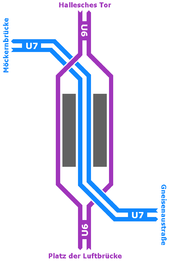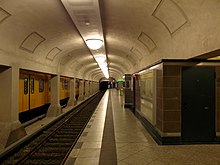Mehringdamm underground station
The Mehringdamm underground station is located below the street of the same name near its intersection with Gneisenaustrasse in the Berlin district of Kreuzberg in the Friedrichshain-Kreuzberg district . It is served by the underground lines U6 and U7 .
History and structure
Interwar period
The station was opened on April 19, 1924 together with the extension of the then line C from Hallesches Tor to Gneisenaustraße as an initially three-track branching station and, like today's Mehringdamm, was called Belle-Alliance-Straße .
In contrast to the train stations on the north-south line that had been built up to that point, the architect Alfred Grenander designed it with a three-aisled vaulted hall, which is unique for Berlin's subway standards.
From February 14, 1926, trains ran to the station Platz der Luftbrücke , which was then opened under the name of Kreuzberg , at the station previously only used for through traffic . Traffic went out of town from the western track, the other two tracks were used in the direction of the city center.
Second World War
Due to a few bomb hits along the route, traffic was temporarily suspended on the night of January 28-29, 1944. The station itself was hit by a bomb in the ceiling area between April 17 and May 7, 1945, the exact date is unknown. On April 23, 1945, operations on all remaining underground lines were suspended.
Post-war period and conversion to a crossing station
Operations could be resumed on June 11, 1945. The renaming of the eponymous street to Franz-Mehring-Straße and a little later to Mehringdamm were also adopted for the train station.
Regardless of the division of Berlin , there were still plans for new underground lines. One planned to cut off the junction in the direction of Neukölln that followed the Mehringdamm station and to expand it into an independent line (today's U7). Due to the future interruption of the flow of traffic from Neukölln to the transfer station at Halleschen Tor, there was fear of overloading the Mehringdamm station despite the planned transfer option at Möckernbrücke underground station .
This is why this was now expanded to four tracks and turned into an intersection-free transfer station. In addition, the originally 80 meter long platforms were extended to 110 meters so that modern six-car trains could also stop here. The vaulted ceiling was also rebuilt under the direction of the architect Rainer Gerhard Rümmler . Preservation aspects were not taken into account, so that the original condition of the station was only visible in photographs for a long time.
On February 28, 1966, the converted station with the new line from Mehringdamm to Möckernbrücke was put into operation. Since then the station has been operated in one-way traffic, with the western platform driving out of town and the eastern platform towards the city center.
In the summer of 1984 the station was given a large glass pulpit for handling the trains, which became superfluous at the end of the 1990s due to the self-handling of train drivers introduced at the time.
Post-turnaround time
In the 1990s, the lighting and the platform surface were renovated, which has since also had black guide strips for the blind .
After some delays the platforms since 2008 with lifts are accessible reach. The costs for this amounted to 1.1 million euros.
From October 2009, the flat ceiling that was drawn in during the renovation was removed again and the station was fundamentally repaired by 2014. The costs were estimated at 4.8 million euros.
Others
With regard to the purchase of the Tempelhofer Feld before the First World War , there were differences between the two then independent communities of Berlin and Tempelhof. As the owner of the new subway, Berlin “punished” the Tempelhof community by declaring the branch to Neukölln to be the main branch, while trains going south only shuttled between Belle-Alliance-Straße and Kreuzberg and there was a continuous connection to Wedding for a long time did not exist.
The southern station exit to Gneisenaustrasse is considered to be one of the weak points in the underground network. The sharp left turn has a gradient of 1:33 with a radius of 100 meters. The point is therefore passed through with signal-dependent speed monitoring.
Since August 3, 2017, the police have been video-recording young men who had brutally attacked a homeless man on May 14, 2017 . One of the perpetrators kicked the 32-year-old in the face with full force and hit him several times. Two other men from the group of four hit the homeless man and kicked him in the face. With the intervention of a woman, they let go of the victim.
Connections and transfer options
The BVG guarantees a direction-related, platform-level transfer between both underground lines within ten minutes without waiting.
There are other transfer options to the BVG bus lines M19 and 140 .
Web links
- BVG map of the station (PDF; 152 kB)
- Description of the Seestraße - Mehringdamm route (north-south subway; U6) including pictures
- [1] [2] More pictures at untergrundbahn.de
Individual evidence
- ↑ a b Jürgen Meyer-Kronthaler: Berlin's subway stations . be.bra, Berlin 1995, ISBN 3-930863-07-3 , pp. 35 .
- ↑ Railway stations in Berlin-Kreuzberg at xhain.info, accessed on July 19, 2015
- ↑ Berliner Verkehrsblätter , edition 3/1984, p. 72
- ↑ Press release of the Berliner Verkehrsbetriebe , December 15, 2008
- ↑ Mehringdamm underground station is getting a new "old" face ( memento from June 24, 2011 in the Internet Archive ) , June 22, 2011
- ↑ Berlin police are looking for subway thugs. In: Spiegel Online , August 3, 2017, accessed on August 4, 2017
Coordinates: 52 ° 29 ′ 40 ″ N , 13 ° 23 ′ 19 ″ E



